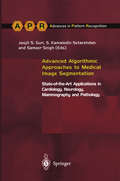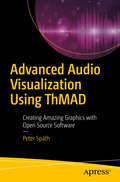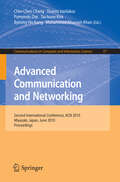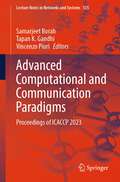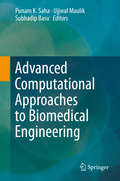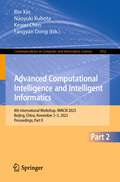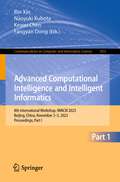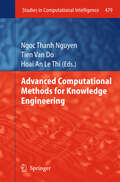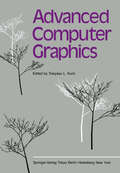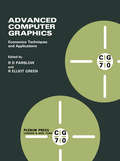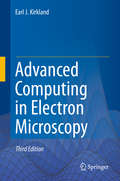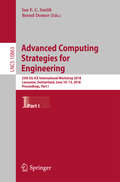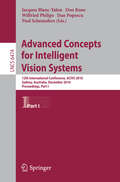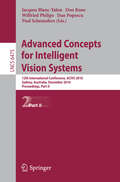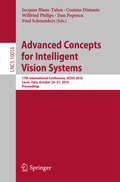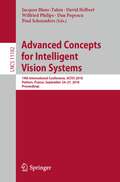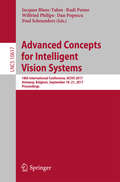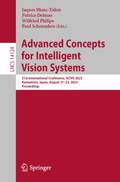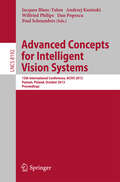- Table View
- List View
Advanced Algorithmic Approaches to Medical Image Segmentation: State-of-the-Art Applications in Cardiology, Neurology, Mammography and Pathology (Advances in Computer Vision and Pattern Recognition)
Medical imaging is an important topic and plays a key role in robust diagnosis and patient care. It has experienced an explosive growth over the last few years due to imaging modalities such as X-rays, computed tomography (CT), magnetic resonance (MR) imaging, and ultrasound. This book focuses primarily on model-based segmentation techniques, which are applied to cardiac, brain, breast and microscopic cancer cell imaging. It includes contributions from authors working in industry and academia, and presents new material.
Advanced Analysis and Design for Fire Safety of Steel Structures (Advanced Topics in Science and Technology in China)
by Guoqiang Li Peijun WangAdvanced Analysis and Design for Fire Safety of Steel Structures systematically presents the latest findings on behaviours of steel structural components in a fire, such as the catenary actions of restrained steel beams, the design methods for restrained steel columns, and the membrane actions of concrete floor slabs with steel decks. Using a systematic description of structural fire safety engineering principles, the authors illustrate the important difference between behaviours of an isolated structural element and the restrained component in a complete structure under fire conditions.The book will be an essential resource for structural engineers who wish to improve their understanding of steel buildings exposed to fires. It is also an ideal textbook for introductory courses in fire safety for master’s degree programs in structural engineering, and is excellent reading material for final-year undergraduate students in civil engineering and fire safety engineering. Furthermore, it successfully bridges the information gap between fire safety engineers, structural engineers and building inspectors, and will be of significant interest to architects, code officials, building designers and fire fighters.Dr. Guoqiang Li is a Professor at the College of Civil Engineering of Tongji University, China; Dr. Peijun Wang is an Associate Professor at the School of Civil Engineering of Shandong University, China.
Advanced Applications in Acoustics, Noise and Vibration
by Frank Fahy John WalkerAdvanced Applications in Acoustics, Noise and Vibration provides comprehensive and up-to-date overviews of knowledge, applications and research activities in a range of topics that are of current interest in the practice of engineering acoustics and vibration technology. The thirteen chapters are grouped into four parts: signal processing, acoustic modelling, environmental and industrial acoustics, and vibration. Following on from its companion volume Fundamentals of Noise and Vibration this book is based partly on material covered in a selection of elective modules in the second semester of the Masters programme in 'Sound and Vibration Studies' of the Institute of Sound and Vibration Research at the University of Southampton, UK and partly on material presented in the annual ISVR short course 'Advanced Course in Acoustics, Noise and Vibration'.
Advanced Audio Visualization Using ThMAD: Creating Amazing Graphics with Open Source Software
by Peter SpäthLearn advanced techniques and improve your audio visualization skills with Thinking Machine Audio Dreams (ThMAD). With this book, you can concentrate on advanced examples and usage patterns, including using shaders in a more profound way, and how to incorporate ThMAD into a tool chain using the professional sound server JACK.Advanced Audio Visualization Using ThMAD provides advanced techniques for generating graphics, improving performance, and providing readers with the skills needed to create more interesting visualizations. You will also learn professional setups with highly developed visual and aural art tool chains.What You'll LearnUse the ThMAD software for advanced setups in their personal and professional projectsGain a pragmatic introduction to using shadersUse JACK sound servers with ThMADControl the timing ThMADWork with advanced configurationsWho This Book Is ForArtists and developers already familiar with ThMAD and looking to enhance their projects. In addition, readers primarily interested in using shaders or the Jack audio server for graphics generation can benefit from the book as well.
Advanced Building Simulation
by Ali Malkawi Godfried AugenbroeThis book introduces recent advances in building simulation and outlines its historic development. Two important topics are described: uncertainty in simulation and coupled simulations, which are both closely linked to attempts to improve control and accuracy. This is followed by coverage of wind simulations and predictions, and then by an introduction to current systems and phenomenological modelling. Written by leading experts in the field both in the US and Europe, Advanced Building Simulation is an excellent graduate-level student textbook as well as a practical guide for architects, engineers and other construction professionals.
Advanced Building Simulation
by Ali M. Malkawi Godfried AugenbroeThis book introduces recent advances in building simulation and outlines its historic development. Two important topics are described: uncertainty in simulation and coupled simulations, which are both closely linked to attempts to improve control and accuracy. This is followed by coverage of wind simulations and predictions, and then by an introduction to current systems and phenomenological modelling. Written by leading experts in the field both in the US and Europe, Advanced Building Simulation is an excellent graduate-level student textbook as well as a practical guide for architects, engineers and other construction professionals.
Advanced Building Technologies for Sustainability (Sustainable Design #3)
by Asif SyedPractical solutions for sustainability In this timely guide, one of the world's leaders in advanced building technology implementation shows architects and engineers proven and practical methods for implementing these technologies in sustainably-designed buildings. Because of the very limited time architects are given from being awarded a project to concept design, this book offers clear and workable solutions for implementing solar energy, radiant heating and cooling floors, displacement ventilation, net zero, and more. It provides helpful tips and suggestions for architects and engineers to work together on implementing these technologies, along with many innovative possibilities for developing a truly integrated design. This book also explores and explains the many benefits of advanced technologies, including reduced greenhouse gas emissions, lower operating costs, noise reduction, improved indoor air quality, and more. In addition, Advanced Building Technologies for Sustainability: Offers detailed coverage of solar energy systems, thermal energy storage, geothermal systems, high-performance envelopes, chilled beams, under-floor air distribution, displacement induction units, and much more Provides case studies of projects using advanced technologies and demonstrates their implementation in a variety of contexts and building types Covers the implementation of advanced technologies in office towers, large residential buildings, hospitals, schools, dormitories, theaters, colleges, and more Complete with a clear and insightful explanation of the requirements for and benefits of acquiring the U.S. Green Building Council's LEED certification, Advanced Building Technologies for Sustainability is an important resource for architects, engineers, developers, and contractors involved in sustainable projects using advanced technologies.
Advanced Building Technologies for Sustainability (Sustainable Design #3)
by Asif SyedPractical solutions for sustainability In this timely guide, one of the world's leaders in advanced building technology implementation shows architects and engineers proven and practical methods for implementing these technologies in sustainably-designed buildings. Because of the very limited time architects are given from being awarded a project to concept design, this book offers clear and workable solutions for implementing solar energy, radiant heating and cooling floors, displacement ventilation, net zero, and more. It provides helpful tips and suggestions for architects and engineers to work together on implementing these technologies, along with many innovative possibilities for developing a truly integrated design. This book also explores and explains the many benefits of advanced technologies, including reduced greenhouse gas emissions, lower operating costs, noise reduction, improved indoor air quality, and more. In addition, Advanced Building Technologies for Sustainability: Offers detailed coverage of solar energy systems, thermal energy storage, geothermal systems, high-performance envelopes, chilled beams, under-floor air distribution, displacement induction units, and much more Provides case studies of projects using advanced technologies and demonstrates their implementation in a variety of contexts and building types Covers the implementation of advanced technologies in office towers, large residential buildings, hospitals, schools, dormitories, theaters, colleges, and more Complete with a clear and insightful explanation of the requirements for and benefits of acquiring the U.S. Green Building Council's LEED certification, Advanced Building Technologies for Sustainability is an important resource for architects, engineers, developers, and contractors involved in sustainable projects using advanced technologies.
Advanced Communication and Networking: 2nd International Conference, ACN 2010, Miyazaki, Japan, June 23-25, 2010. Proceedings (Communications in Computer and Information Science #77)
by Thanos Vasilakos Purnendu Das Byeong-Ho Kang Muhammad Khurram KhanAdvanced Science and Technology, Advanced Communication and Networking, Information Security and Assurance, Ubiquitous Computing and Multimedia Appli- tions are conferences that attract many academic and industry professionals. The goal of these co-located conferences is to bring together researchers from academia and industry as well as practitioners to share ideas, problems and solutions relating to the multifaceted aspects of advanced science and technology, advanced communication and networking, information security and assurance, ubiquitous computing and m- timedia applications. This co-located event included the following conferences: AST 2010 (The second International Conference on Advanced Science and Technology), ACN 2010 (The second International Conference on Advanced Communication and Networking), ISA 2010 (The 4th International Conference on Information Security and Assurance) and UCMA 2010 (The 2010 International Conference on Ubiquitous Computing and Multimedia Applications). We would like to express our gratitude to all of the authors of submitted papers and to all attendees, for their contributions and participation. We believe in the need for continuing this undertaking in the future. We acknowledge the great effort of all the Chairs and the members of advisory boards and Program Committees of the above-listed events, who selected 15% of over 1,000 submissions, following a rigorous peer-review process. Special thanks go to SERSC (Science & Engineering Research Support soCiety) for supporting these - located conferences.
Advanced Computational and Communication Paradigms: Proceedings of ICACCP 2023 (Lecture Notes in Networks and Systems #535)
by Samarjeet Borah Tapan K. Gandhi Vincenzo PiuriThis book presents high-quality, peer-reviewed papers from Fourth International Conference on Advanced Computational and Communication Paradigms (ICACCP 2023), organized by Department of Computer Science and Engineering (CSE), Sikkim Manipal Institute of Technology (SMIT), Sikkim, India, during February 16–18, 2023. ICACCP 2023 covers advanced computational paradigms and communications technique which provides failsafe and robust solutions to the emerging problems faced by mankind. Technologists, scientists, industry professionals, and research scholars from regional, national, and international levels are invited to present their original unpublished work in this conference.
Advanced Computational Approaches to Biomedical Engineering
by Punam K. Saha Ujjwal Maulik Subhadip BasuThere has been rapid growth in biomedical engineering in recent decades, given advancements in medical imaging and physiological modelling and sensing systems, coupled with immense growth in computational and network technology, analytic approaches, visualization and virtual-reality, man-machine interaction and automation. Biomedical engineering involves applying engineering principles to the medical and biological sciences and it comprises several topics including biomedicine, medical imaging, physiological modelling and sensing, instrumentation, real-time systems, automation and control, signal processing, image reconstruction, processing and analysis, pattern recognition, and biomechanics. It holds great promise for the diagnosis and treatment of complex medical conditions, in particular, as we can now target direct clinical applications, research and development in biomedical engineering is helping us to develop innovative implants and prosthetics, create new medical imaging technologies and improve tools and techniques for the detection, prevention and treatment of diseases.The contributing authors in this edited book present representative surveys of advances in their respective fields, focusing in particular on techniques for the analysis of complex biomedical data. The book will be a useful reference for graduate students, researchers and industrial practitioners in computer science, biomedical engineering, and computational and molecular biology.
Advanced Computational Intelligence and Intelligent Informatics: 8th International Workshop, IWACIII 2023, Beijing, China, November 3–5, 2023, Proceedings, Part II (Communications in Computer and Information Science #1932)
by Bin Xin Naoyuki Kubota Kewei Chen Fangyan DongThis two-volume set constitutes the refereed proceedings of the 8th International Workshop on Advanced Computational Intelligence and Intelligent Informatics, IWACIII 2023, held in Beijing, China, in November 2023.The 56 papers presented were thoroughly reviewed and selected from the 118 qualifies submissions. They are organized in the topical sections on intelligent information processing; intelligent optimization and decision-making; pattern recognition and computer vision; advanced control; multi-agent systems; robotics.
Advanced Computational Intelligence and Intelligent Informatics: 8th International Workshop, IWACIII 2023, Beijing, China, November 3–5, 2023, Proceedings, Part I (Communications in Computer and Information Science #1931)
by Bin Xin Naoyuki Kubota Kewei Chen Fangyan DongThis two-volume set constitutes the refereed proceedings of the 8th International Workshop on Advanced Computational Intelligence and Intelligent Informatics, IWACIII 2023, held in Beijing, China, in November 2023.The 56 papers presented were thoroughly reviewed and selected from the 118 qualifies submissions. They are organized in the topical sections on intelligent information processing; intelligent optimization and decision-making; pattern recognition and computer vision; advanced control; multi-agent systems; robotics.
Advanced Computational Methods for Knowledge Engineering (Studies in Computational Intelligence #479)
by Ngoc Thanh Nguyen Tien Van Do Hoai An ThiThe book consists of 29 extended chapters which have been selected and invited from the submissions to the 1st International Conference on Computer Science, Applied Mathematics and Applications (ICCSAMA 2013) held on 9-10 May, 2013 in Warsaw, Poland. The book is organized into five parts, which are: Advanced Optimization Methods and Their Applications, Queuing Theory and Applications, Computational Methods for Knowledge Engineering, Knowledge Engineering with Cloud and Grid Computing, and Logic Based Methods for Decision Making and Data Mining, respectively. All chapters in the book discuss theoretical and practical issues connected with computational methods and optimization methods for knowledge engineering.
Advanced Computer Graphics: Proceedings of Computer Graphics Tokyo ’86
by Tosiyasu L. KuniiComputer Graphics Tokyo, now in its fourth year, has established a world-wide reputation as an international technical conference, presenting work of high quality in the field of computer graphics. Each conference has been attended by a couple of thousand partiCipants from all over the world and tens of thousands have visited the exhibition. After strict peer review, 34 papers were accepted this year, of which about 40% were from the USA, 30% from Japan, 20% from Europe, and 10% from Canada. A good balance of papers on advanced research results, industrial/marketing surveys, and computer art technology has made Computer Graphics Tokyo an indispensable forum for researchers, engineers, and administrators working in this field. Computer graphics is a rapidly developing and expanding area and it is not easy to keep abreast of all the progress that has been made. This volume contains the proceedings of Computer Graphics Tokyo '86 and provides the reader with a comprehensive survey of the state of the art in computer graphics. Computational geometry (Chapter 1) is one of the fastest growing areas in computer graphics. This is well recognized as the basis of shape modeling. After shapes are modeled, they are displayed for visual observation. Chapter 2 on rendering presents various novel methods and technological innovations for visualizing shapes. To make display systems more acces sible to users, rich visual interfaces and languages are being designed, as shown in Chapter 3. Visual data bases for sharing graphics-and image-data are handled in Chapter 4.
Advanced Computer Graphics: Economics Techniques and Applications
by Robert Douglas Parslow Richard Elliot GreenComputer graphics is no longer merely a technique of promise. The case studies in this book prove that it is a technique which has already identified itself with progress in an astonishingly wide range of app lications, to the extent that it has been necessary to group many chapters into sections dealing with specific categories, such as the design of electrical circuits, civil engineering, architecture, nuclear and space science and text editing. In the last couple of years, computer graphics has blossomed out from the stage in which it was confined almost exclusively to the large scale industries of aircraft and automobile engineering. It has also developed additional advantages, mote than the simple idea of doing the same thing more quickly. Now the technique offers entirely new ways of doing old things, with consequent greater efficiency and accuracy; and it also brings a way of doing new things, which were previously not possible. In the introduction to their paper in Part 12, Armit and Forrest state: "We do not discuss those systems which are merely computer versions of existing design methods, but rather those systems which make use of techniques for design which are beyond the possibilities of conventional drafting." Similarly, Ranaweer3; and Leckie end their paper in Part 4 with the comment: "Thus the man and the machine can work as a team to arrive at a solution better than that which can be arrived at by either one alone".
Advanced Computing in Electron Microscopy
by Earl J. KirklandThis updated and revised edition of a classic work provides a summary of methods for numerical computation of high resolution conventional and scanning transmission electron microscope images. At the limits of resolution, image artifacts due to the instrument and the specimen interaction can complicate image interpretation. Image calculations can help the user to interpret and understand high resolution information in recorded electron micrographs. The book contains expanded sections on aberration correction, including a detailed discussion of higher order (multipole) aberrations and their effect on high resolution imaging, new imaging modes such as ABF (annular bright field), and the latest developments in parallel processing using GPUs (graphic processing units), as well as updated references. Beginning and experienced users at the advanced undergraduate or graduate level will find the book to be a unique and essential guide to the theory and methods of computation in electron microscopy.
Advanced Computing Strategies for Engineering: 25th EG-ICE International Workshop 2018, Lausanne, Switzerland, June 10-13, 2018, Proceedings, Part I (Lecture Notes in Computer Science #10863)
by Ian F. Smith Bernd DomerThis double volume set ( LNAI 10863-10864) constitutes the refereed proceedings of the 25th International Workshop, EG-ICE 2018, held in Lausanne, Switzerland, in June 2018. The 58 papers presented in this volume were carefully reviewed and selected from 108 submissions. The papers are organized in topical sections on Advanced Computing in Engineering, Computer Supported Construction Management, Life-Cycle Design Support, Monitoring and Control Algorithms in Engineering, and BIM and Engineering Ontologies.
Advanced Concepts for Intelligent Vision Systems: 12th International Conference, ACIVS 2010, Sydney, Australia, December 13-16, 2010, Proceedings, Part I (Lecture Notes in Computer Science #6474)
by Jacques Blanc-Talon Don Bone Wilfried Philips Dan Popescu Paul ScheundersThis volume collects the papers accepted for presentation at the 12th Int- national Conference on “Advanced Concepts for Intelligent Vision Systems” (ACIVS 2010). Following the ?rst meeting in Baden-Baden (Germany) in 1999, whichwaspartofalargemulticonference,theACIVSconferencethendeveloped into an independent scienti?c event and has ever since maintained the tradition of being a single track conference. ACIVS 2010 attracted computer scientists from 29 di?erent countries, mostly from Europe, Australia, and the USA, but also from Asia. Although ACIVS is a conference on all areas of image and video processing, submissions tend to gather within certain major ?elds of interest. This year 3D and depth processing and computer vision and surveillance were popular topics. Noteworthy are the growing number of papers related to theoretical devel- ments. We would like to thank the invited speakers Mubarak Shah (University of Central Florida), Richard Kleihorst (VITO, Belgium), Richard Hartley (A- tralian National University), and David Suter (Adelaide University) for their valuable contributions.
Advanced Concepts for Intelligent Vision Systems: 12th International Conference, ACIVS 2010, Sydney, Australia, December 13-16, 2010, Proceedings, Part II (Lecture Notes in Computer Science #6475)
by Jacques Blanc-Talon Don Bone Wilfried Philips Dan Popescu Paul ScheundersAdvanced Concepts for Intelligent Vision Systems: 17th International Conference, ACIVS 2016, Lecce, Italy, October 24-27, 2016, Proceedings (Lecture Notes in Computer Science #10016)
by Jacques Blanc-Talon Cosimo Distante Wilfried Philips Dan Popescu Paul ScheundersThis book constitutes the refereed proceedings of the 17th International Conference on Advanced Concepts for Intelligent Vision Systems, ACIVS 2016, held in Lecce, Italy, in October 2016.The 64 revised full papers presented in this volume were carefully selected from 137 submissions. They deal with classical low-level image processing techniques; image and video compression; 3D; security and forensics; and evaluation methodologies.
Advanced Concepts for Intelligent Vision Systems: 19th International Conference, ACIVS 2018, Poitiers, France, September 24–27, 2018, Proceedings (Lecture Notes in Computer Science #11182)
by Jacques Blanc-Talon David Helbert Wilfried Philips Dan Popescu Paul ScheundersThis book constitutes the refereed proceedings of the 19th International Conference on Advanced Concepts for Intelligent Vision Systems, ACIVS 2018, held in Poitiers, France, in September 2018. The 52 full papers presented in this volume were carefully reviewed and selected from 91 submissions. They were organized in topical sections named: video analysis; segmentation and classification; remote sending; biometrics; deep learning; coding and compression; and image restauration and reconstruction.
Advanced Concepts for Intelligent Vision Systems: 18th International Conference, ACIVS 2017, Antwerp, Belgium, September 18-21, 2017, Proceedings (Lecture Notes in Computer Science #10617)
by Jacques Blanc-Talon Rudi Penne Wilfried Philips Dan Popescu Paul ScheundersThis book constitutes the refereed proceedings of the 18th International Conference on Advanced Concepts for Intelligent Vision Systems, ACIVS 2017, held in Antwerp, Belgium, in September 2017.The 63 full papers presented in this volume were carefully selected from 134 submissions. They deal with human-computer interaction; classification and recognition; navigation, mapping, robotics, and transports; video processing and retrieval; security, forensics, surveillance; and image processing.
Advanced Concepts for Intelligent Vision Systems: 21st International Conference, ACIVS 2023 Kumamoto, Japan, August 21–23, 2023 Proceedings (Lecture Notes in Computer Science #14124)
by Jaques Blanc-Talon Patrice Delmas Wilfried Philips Paul ScheundersThis book constitutes the proceedings of the 21st International Conference on Advanced Concepts for Intelligent Vision Systems, ACIVS 2023, held in Kumamoto, Japan, during August 2023. The 31 papers presented in this volume were carefully reviewed and selected from a total of 48 submissions. They were organized in topical sections named: Computer Vision, Affective Computing and Human Interactions, Managing the Biodiversity, Robotics and Drones, Machine Learning.
Advanced Concepts for Intelligent Vision Systems: 15th International Conference, ACIVS 2013, Poznań, Poland, October 28-31, 2013, Proceedings (Lecture Notes in Computer Science #8192)
by Jaques Blanc-Talon Andrzej Kasiniski Wilfried Philips Dan Popescu Paul ScheundersThis book constitutes the thoroughly refereed proceedings of the 15th International Conference on Advanced Concepts for Intelligent Vision Systems, ACIVS 2013, held in Poznań, Poland, in October 2013. The 63 revised full papers were carefully selected from 111 submissions. The topics covered are aquisition, pre-processing and coding, biometry, classification and recognition, depth, 3D and tracking, efficient implementation and frameworks, low level image analysis, segmentation and video analysis.
